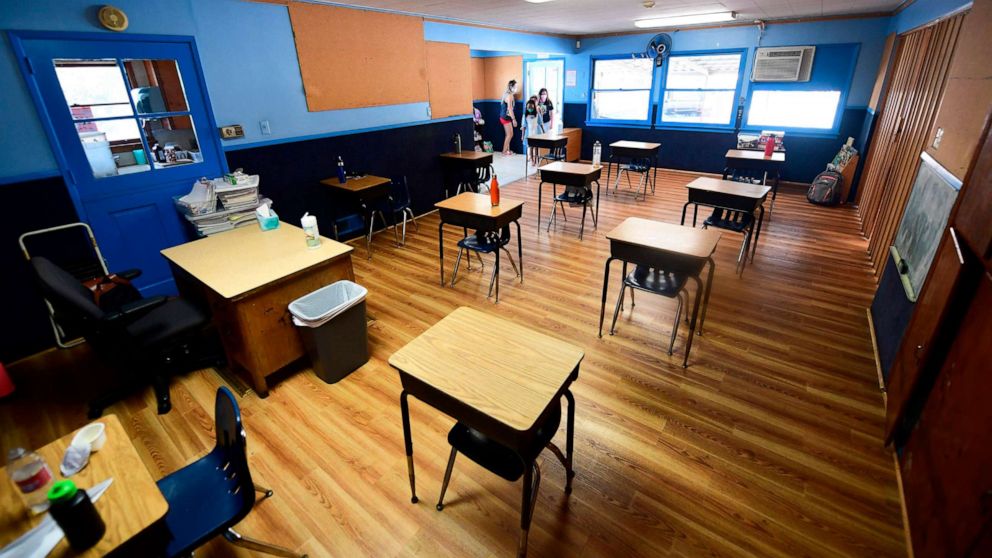
A new study at the University of Minnesota College of Science and Engineering showed that ventilation systems can change the spread of aerosolized and potentially virus-containing particles in common indoor areas. The study looked at the results in an elevator, a supermarket, and a classroom.
Although their findings are still in the process of peer review, they have drawn the attention of an anxious nation preparing to send children back to school and anxious for any small hint on how to stay safe and reduce transmission in the inside.
Dr. Jiarong Hong and Dr. Suo Yang, associate professors of mechanical engineering at the University of Minnesota, analyzed how aerosolized and potentially virus-containing particles could spread to common indoor areas using computer simulation.
To start, they evaluated eight asymptomatic participants with COVID and calculated the spread of particles from actions such as talking, coughing, and sneezing. They took this data and applied it in various computer simulations.
In a simulation, they created various circumstances in a standard classroom, with a teacher in front and children scattered throughout the room. In other simulations, they did the same thing, but in an elevator or in a grocery store. They studied various conditions, including how the spread would change if the rooms had a powerful fan at the entrance or at the back of the room.
They found that in interior spaces, good ventilation will filter some of the virus out of the air, but can leave more viral particles on surfaces, such as walls. Key among their findings: Aerosols spread significantly less throughout the room when the asymptomatic person was placed directly under an air vent rather than away from it.
This could come into play in the classroom, with a theoretically lower risk of transmission if an unknown asymptomatic teacher were placed directly below the ventilation system. Conversely, a ventilation system in the back of the room could spread potentially infectious particles throughout the room.
“If the teacher is out front, the ventilation is in the back, the ventilation will draw the spray throughout the classroom.” says Suo Yang, one of the principal investigators. “In comparison, if we move the ventilation to the front, just above the master, then the ventilation will create a recirculation zone in the front, which will limit aerosols within the front 1/3 of the class.”
For the classroom case, with strong simulated ventilation, only around 10% of the particles were expelled, which means you may not necessarily have a high quality ventilation system to filter out all potentially infectious particles in a standard classroom .
A grocery store, meanwhile, was a different story. In the simulated supermarket, 50% of the particles were ejected, according to the computer simulation, and Yang found that the tall shelves of a supermarket create small wind channels that circulate air more efficiently through a room.
In both scenarios, many of the particles ended up on surfaces, such as the floor and walls.
“With very strong ventilation, it doesn’t mean it takes off aerosols. We found that surface deposition is huge. That means regular surface cleaning is important,” Yang said.
It is important to note that this study is currently under peer review. Experts caution that the study has limits, and its conclusions should not apply in a diverse set of settings. Each classroom, grocery store, and elevator is unique and must be specifically evaluated to determine the risk of transmission. Nor do the findings offered by some scenarios reduce risk mean that people should replace typical COVID-19 security measures, such as social distancing and facial coverage.
“Modeling could be useful, but we must also understand that there are many possible scenarios for the same interior space, so it is not possible to model all scenarios,” said Rajat Mittal, professor of mechanical engineering at Johns Hopkins University and an expert. in fluid dynamics.
However, Mittal said the results are “in line with what has been found in previous studies.”
For Yang, one of the most important conclusions of his research is that a good ventilation system is not a silver bullet to reduce indoor transmission.
“Normally people think ventilation will help. Our observation is that it depends on how the room is set up and where the ventilation is,” Yang said. “Sometimes it helps, sometimes it helps the dispersion. The key observation is the relative location of the ventilation.”
Alexis E. Carrington, MD, a dermatology researcher at the University of California, Davis in Sacramento, California, and a contributor to the ABC News Medical Unit. Sony Salzman is the coordinating producer for ABC News Medical Unit.
.